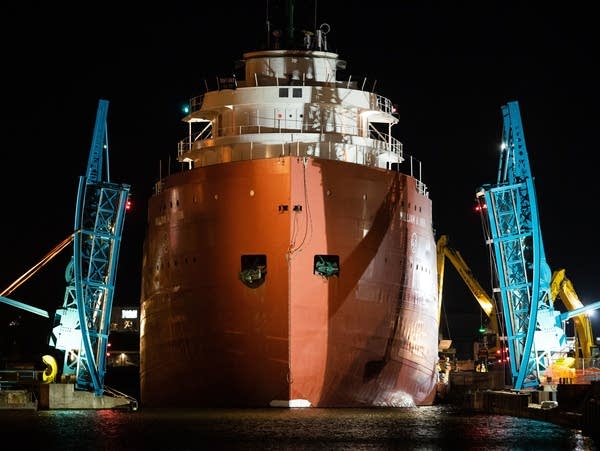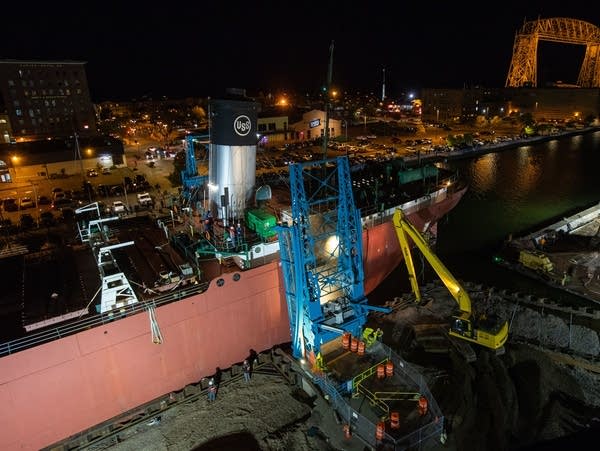Threading the needle: Mammoth Duluth museum ship eased out of longtime berth

Go Deeper.
Create an account or log in to save stories.
Like this?
Thanks for liking this story! We have added it to a list of your favorite stories.
You think parallel parking is hard?
Try threading a mammoth Great Lakes freighter through the opening of a narrow drawbridge — with only 7 inches to spare on either side.
That was the tricky task that crews in Duluth faced late Friday night, when they had to move the landmark William A. Irvin museum ship from the berth it has called home for decades.

With a nearly full moon illuminating the scene, a couple hundred people waited alongside the Minnesota Slip that sits between Canal Park — the city's tourism district — and the Duluth Entertainment Convention Center. They were there to see the 610-foot-long Irvin move from the slip where it's been docked for more than 30 years.
Turn Up Your Support
MPR News helps you turn down the noise and build shared understanding. Turn up your support for this public resource and keep trusted journalism accessible to all.
Among the crowd was Nicole Jukich, 25, of Duluth. Jukich said she loves "everything about boats," and brought popcorn, root beer and four blankets for the show.
"I am going to stay here until I cannot see that boat anymore," she said.
Why the interest?

"My dad's dad used to sail on them, and I never got to meet my dad's dad, and my dad also sailed on them as well," she said. "So they're very close to my heart."
Jim Steenerson of Duluth also was part of the crowd.
"Well, this ship has been sitting down here in the harbor for 30 years, and we've toured it, and we've seen it a million times, and we thought that this was a once-in-a-lifetime opportunity to see it moved," he said.
An average of 36,000 people tour the Irvin every year. But the city had a deadline to move the ship out of the slip by the end of September to allow for the $1.9 million cleanup of underwater sediment that's contaminated with decades-old industrial pollution.

The complicating factor was the Minnesota Slip pedestrian drawbridge, which was built after the Irvin was put in place — leaving just barely enough room to get it out.
The ship was closed to tourists this summer, but guide Cedric Woodard provided a special tour ahead of the big move.
The Irvin was built in 1938, U.S. Steel's first ship after the Great Depression. From up on deck, the gap through the pedestrian drawbridge looked almost impossibly narrow.
"Doesn't look like it's going to go through, does it! I'm glad I'm not steering it through," Woodard laughed.

Woodard worked on Great Lakes ships for 20 years as a wheelsman, meaning he actually steered them. He said the tightest squeeze he ever had was maybe 5 feet on either side, coming into the Soo Locks.
The Irvin's engines haven't operated in years. So to make the move, winches were connected to barges anchored near the ship, and to the side of the slip.
Chad Scott with AMI Consulting Engineers helped figure out how exactly to execute the delicate move.

"So we'll have four lines on the vessel at all times, and you're going to have a braking and a pulling winch. So the pulling winch is going to start the movement, (and) the braking winch is there in case we have to stop and realign the vessel," he said ahead of the move.
And finally, on Friday night at about 10 minutes before 10, the winches slowly started to move the Irvin. Emphasis on "slowly." The maximum speed was one foot every four seconds.
"I think that's the big thing that people don't understand, is when you have a large, heavy vessel like that, you have to move extremely slow," Scott said.

Scott said another key was the repair of the seawall along the side of the slip, which dated back to the late 1800s. A $6.1 million project this summer shored up the wall and straightened it, which allowed for the ship to be pulled out in a straight line toward the opening through the bridge.
As the ship glided stern-first, farther and farther through the bridge opening and out into the Duluth harbor, Scott got more and more nervous.
"Well, because you've got so much of the vessel out there, if we had really high winds right now — there's a lot of sail out here. As you come out of the slip, you're exposed more to the weather."

Which heightened the risk of the ship getting pinched if it went just slightly off-kilter.
But more than two-and-a-half hours after it began to move, the ship's bow eased through the bridge opening to cheers from the crowd.
"It's amazing, it finally cleared the bridge at 12:28 a.m.," Jukich said. "It's crazy. They did a very good job."

Jukich said she's glad she stuck it out.
"I'm a true boat nerd, and I said I'd stay until the end, and it finally cleared the bridge — but it may be time to go home now," she said.
The William A. Irvin made it to Fraser Shipyards across the harbor in Superior, Wis., by 4 a.m. Over the winter it will have its corroded hull repaired.
And then next spring, boat nerds will likely be back along Duluth's Minnesota Slip in force, when crews will orchestrate the complicated move one more time to bring the Irvin back home.






